Key takeaways
- Narrative structure shapes the emotional experience of a film, influencing how audiences perceive and engage with the story.
- Christopher Nolan’s storytelling often involves non-linear sequences and layered timelines, inviting viewers to actively participate in piecing together the narrative.
- Critics appreciate Nolan’s blend of complexity and accessibility, noting that his films remain emotionally resonant despite their intricate plots.
- Applying Nolan’s techniques in film critique encourages deeper analysis of pacing, tension, and the construction of narratives, enhancing appreciation for the craft behind filmmaking.
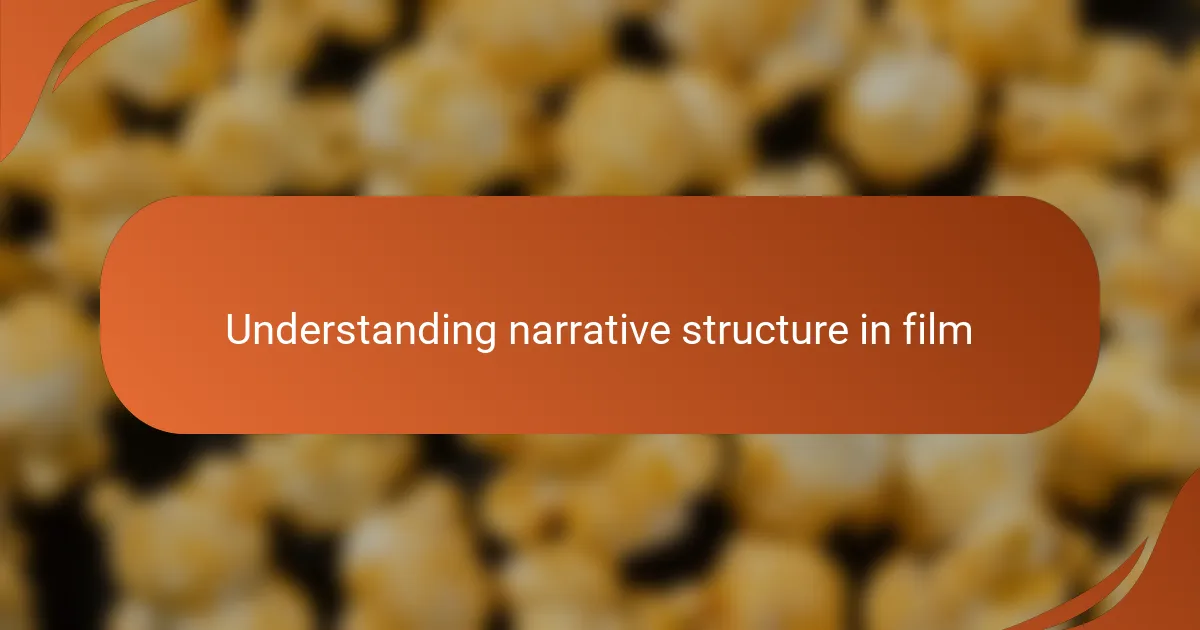
Understanding narrative structure in film
Narrative structure in film is more than just the order of events; it’s the framework that shapes how a story feels and flows. When I first started paying attention to this, I realized that a well-crafted narrative can make even a simple plot feel deeply complex and engaging. Have you ever watched a movie where the timeline is jumbled, and it both confused and fascinated you? That’s narrative structure playing with your perception.
What fascinates me about narrative structure is its power to evoke emotions by controlling what we know and when we know it. It’s like the director is guiding you by the hand, deciding when to reveal key moments to maximize impact. For example, films that use flashbacks or non-linear storytelling create a sense of mystery and keep me hooked because I constantly piece together the puzzle alongside the characters.
Understanding narrative structure also helps me appreciate how filmmakers build tension and pacing. It’s not just about the story being told but how it’s delivered — the rhythm of scenes, the layering of information, and the timing of reveals all work together. I often catch myself thinking about this after a film ends, replaying scenes in my mind and admiring the craft behind what seemed effortless on screen. Doesn’t that make you want to watch films more attentively?

Overview of Christopher Nolan’s storytelling style
Christopher Nolan’s storytelling style has always intrigued me because it challenges traditional narrative forms. He frequently plays with time—using non-linear sequences and overlapping timelines—to create a layered experience that demands active engagement. I remember watching “Memento” and feeling my mind stretch as the pieces slowly came together backwards; it was exhilarating.
What I find particularly striking is how Nolan balances complexity with clarity. His narratives are intricate, but never intentionally confusing; instead, they invite you to think deeply and notice details you might otherwise miss. Have you ever felt like a detective piecing together clues while watching his films? That’s the kind of immersive experience he crafts with precision.
Nolan’s use of perspective also adds emotional depth to his stories. By shifting viewpoints or focusing tightly on individual consciousness, he brings a human element to seemingly grand, abstract concepts like time, memory, or reality. This approach makes his films feel both intellectually stimulating and profoundly personal, which is a balance few directors manage to achieve.
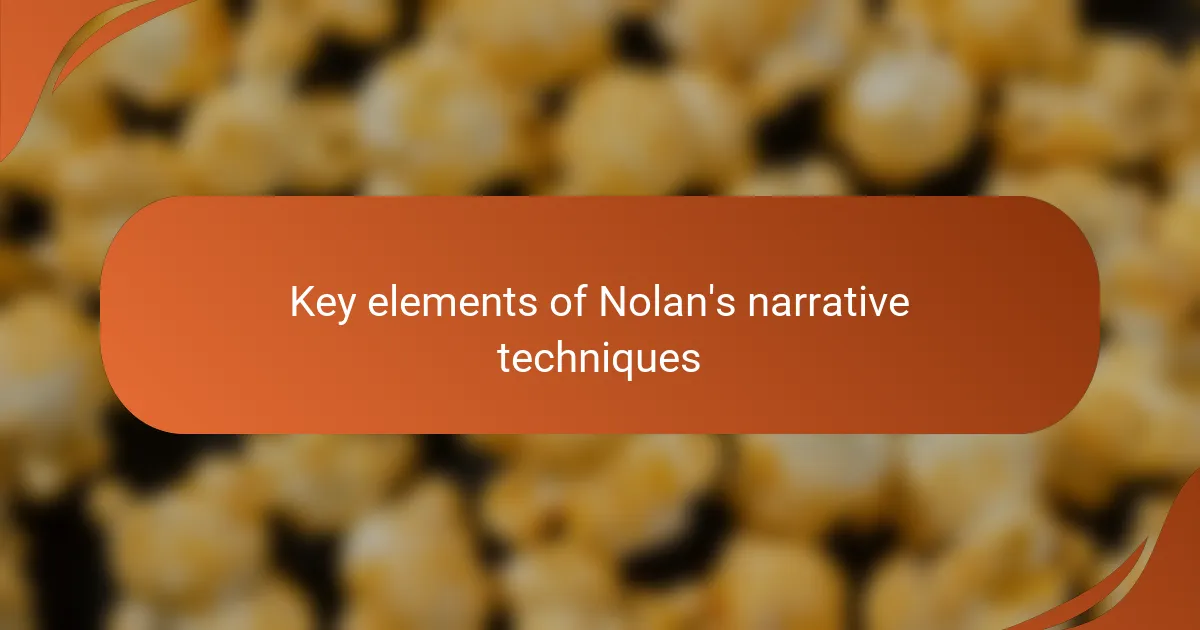
Key elements of Nolan’s narrative techniques
One element of Nolan’s narrative technique that I always notice is his mastery of non-linear storytelling. It’s not just a gimmick; it’s a way to immerse the audience in the character’s experience of time and memory. I remember watching “Inception” and feeling completely drawn into the dream layers because the timeline shifted so seamlessly—have you ever had that sensation where you’re unsure what’s reality, yet you don’t want to look away?
Another key aspect I admire is Nolan’s use of repetition and variation within his narratives. He often revisits certain scenes or motifs but from different perspectives or with new information. This technique made me rethink earlier moments in films like “Dunkirk,” where the intersecting timelines created a richer emotional impact once I saw how events from different viewpoints connected.
What truly sets Nolan apart, in my view, is his attention to pacing and information control. He knows exactly when to reveal critical plot points to keep the tension high without losing the audience. I’ve caught myself holding my breath during those moments when everything clicks together, and it’s clear that this careful structure is what elevates his movies beyond straightforward storytelling. Have you experienced that same thrilling payoff after piecing together his narrative puzzle?
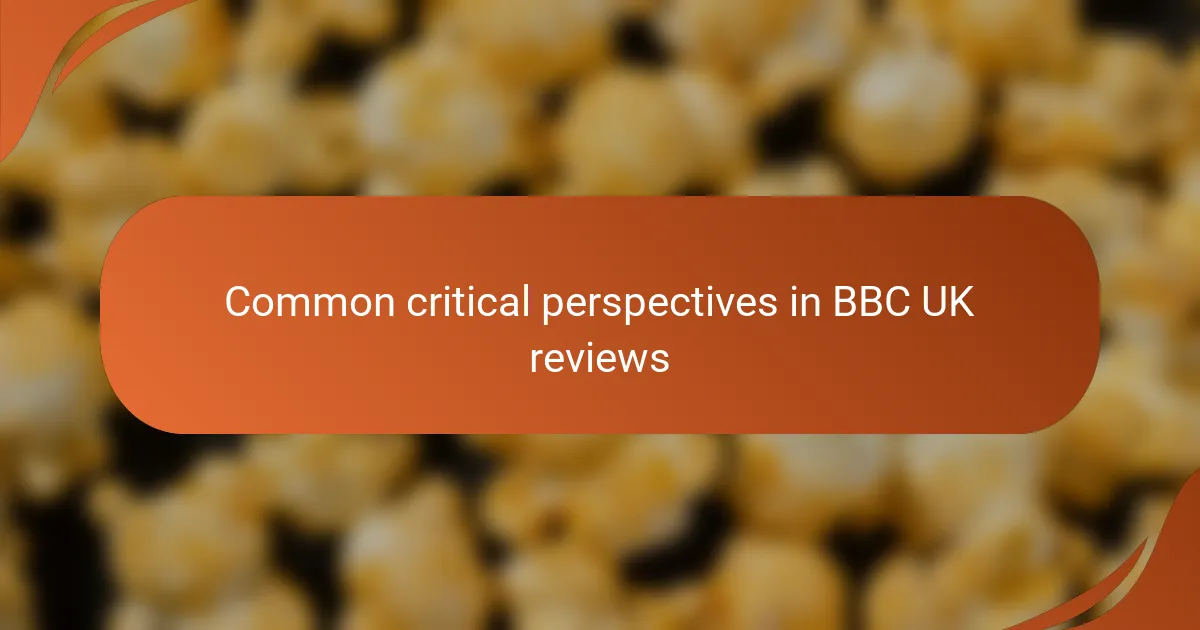
Common critical perspectives in BBC UK reviews
BBC UK movie reviews often highlight the complexity and ambition of Nolan’s narrative structure, praising how his films push the boundaries of conventional storytelling. From my experience reading these reviews, critics admire the intellectual challenge his narratives present, even if some viewers find them initially baffling. It made me wonder—do we need to work harder as an audience to truly appreciate his craft?
Critics frequently point out Nolan’s skillful balance between innovation and accessibility. I’ve noticed many reviews emphasize that, despite convoluted timelines or intricate plot devices, his films remain emotionally resonant and engaging. This aligns with my own viewing experiences, where I felt drawn in not just by the puzzle but also by the human stories beneath.
Another common thread in BBC UK reviews is the attention given to Nolan’s control over narrative pacing and tension. Reviewers acknowledge how carefully orchestrated reveals keep viewers invested from start to finish. I recall reading a review that described this as a “director’s game of chess,” and I can’t help but agree—watching a Nolan film feels like being part of a high-stakes mental match.
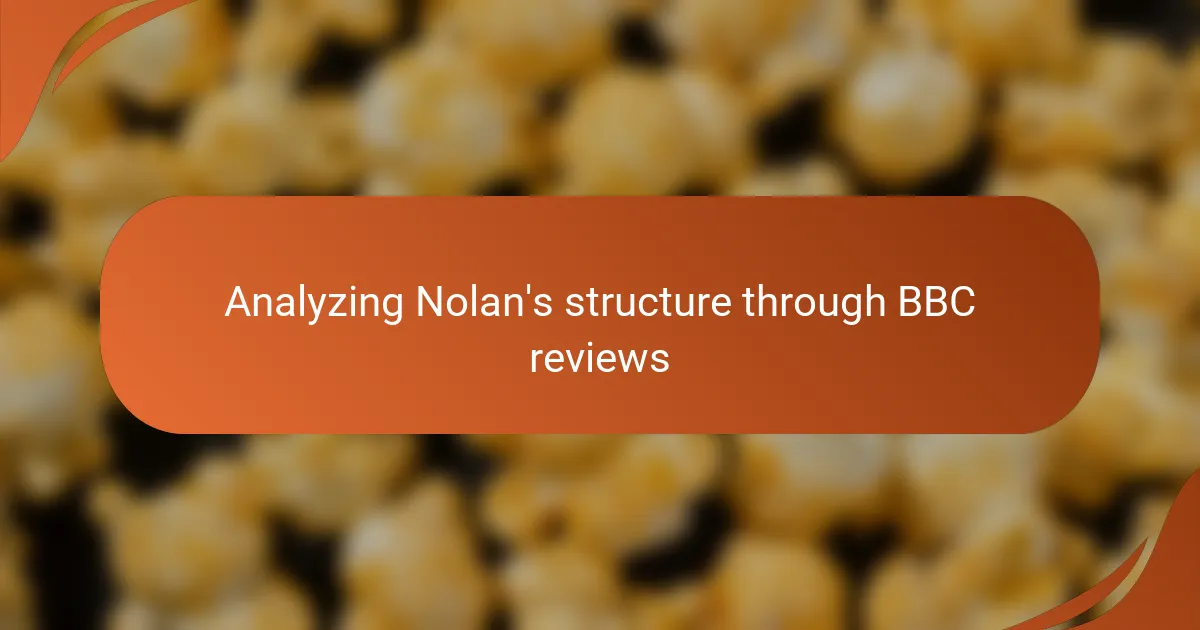
Analyzing Nolan’s structure through BBC reviews
When I dove into BBC UK reviews on Nolan’s narrative structure, I was struck by how consistently critics celebrate his complexity without dismissing its emotional core. They often echo what I’ve felt firsthand: his stories demand mental effort but reward you with a deeply satisfying emotional journey. Isn’t it refreshing when a film challenges your brain and touches your heart at the same time?
What really resonated with me from these reviews was the way they highlighted Nolan’s pacing and control over information. One review described his storytelling like a “director’s game of chess,” which perfectly captures that mix of strategy and suspense I experience watching his films. Have you ever found yourself holding your breath, suddenly realizing all those scattered pieces are clicking together just when you least expect it? That’s the kind of narrative mastery both critics and I admire.
BBC reviewers also raise an interesting point about accessibility. Despite Nolan’s labyrinthine timelines and layered perspectives, his films still connect on a human level—something I’ve always appreciated. It made me think: can complexity and clarity truly coexist in storytelling? Nolan’s work, as these reviews suggest, shows us that it’s possible—and thrilling—when done with skill.

Personal insights on Nolan’s narrative impact
Nolan’s narrative impact, to me, lies in the way his stories linger long after the credits roll. I’ve found myself replaying scenes, not just to catch missed details but to feel the emotional weight again—like when “Interstellar” left me grappling with time and love simultaneously. Have you ever had a film stay with you, shifting your perspective days later? That’s Nolan’s storytelling at work.
What strikes me most is how his structure forces me to be an active participant rather than a passive viewer. There’s a thrill in piecing together his puzzles, but also a subtle emotional resonance beneath it all. I recall watching “Dunkirk” and sensing this intense urgency and vulnerability, even as the timelines looped and intertwined—did you feel that heartbeat of humanity amidst the complexity?
Sometimes I wonder if this narrative complexity risks alienating casual viewers, yet Nolan’s films continually draw me back because they trust my intelligence without sacrificing feeling. It’s a delicate balance, and in my experience, few filmmakers achieve it so deftly. Don’t you think that’s what makes his impact so enduring and deeply personal?
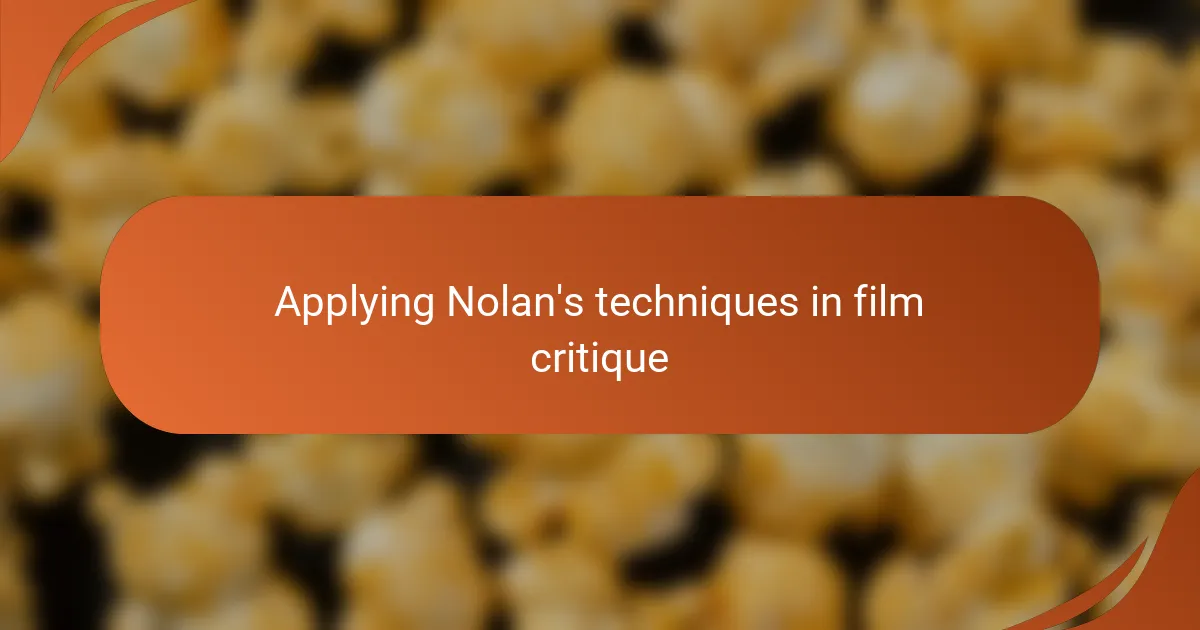
Applying Nolan’s techniques in film critique
Applying Nolan’s narrative techniques in film critique has transformed the way I watch and analyze movies. Instead of simply summarizing the plot, I focus on how the story is constructed—where the timeline bends, which perspectives shift, and how information is gradually unveiled. This approach deepens my appreciation, revealing layers I might have missed if I just followed the story straightforwardly.
When I critique films using Nolan’s methods, I ask myself: Does the narrative invite active participation? Are there puzzles or repeated motifs that challenge my understanding? For example, while reviewing a recent thriller, I noticed how non-linear scenes created suspense by delaying key revelations—something Nolan often does brilliantly. Isn’t it exciting to uncover those hidden threads and see how they weave into a larger meaning?
I also pay close attention to pacing and tension—two elements Nolan masters with remarkable precision. There’s an art in balancing complexity without overwhelming the viewer, making sure each twist lands at just the right moment. From my experience, recognizing this when critiquing helps me explain why certain films grip audiences emotionally, not just intellectually. Have you ever felt that rush when everything suddenly clicks, and the director’s craftsmanship shines through? That’s the kind of insight Nolan’s techniques have taught me to look for.